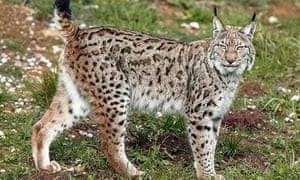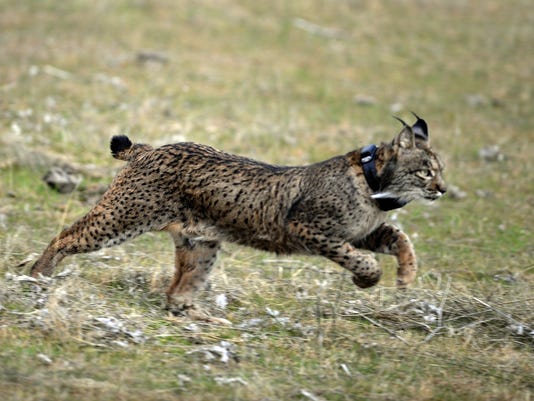The Beautiful Big Cat
"[The undertaking of breeding Iberian lynxes in captivity is costly and complex, somewhat like] having a nursery for rich kids, in which you have one teacher for each kid."
"We like to say beauty isn't everything, but it does count and -- let's be frank -- the lynx sells extremely well [as an endangered species requiring public funds toward reversing threats of extinction]."
Angelo Salso, Italian official, Brussels, manager, European Commission's Life environmental program
 |
| An Iberian lynx at a nature reserve in Spain. Photograph: Victor Fraile/Reuters/Corbis |
"This lynx clearly evolved to be a rabbit hunter on the Iberian Peninsula -- and the price for being such a precious and specialized hunter is a higher [degree of] vulnerability."
Urs Breitennmoser, feline specialist, International Union for Conservation of Nature
"If the lynx disappears, we will of course continue to live on this planet, but I don't think with the same quality of life."
Javier Madrid, environmental official, Andalusian regional government
"We've seen the species recover, but it's still in danger. I'd love to see it, but I can't imagine a time when we won't need programs like this. We've got a lot of work ahead of us."
"We have a 70% survival rate. That's good, very good. Anything over 50% is a success."
"We get through around 600 rabbits a month."
"We have to avoid them getting used to human presence. Also there's always a risk of people bringing some cat or dog disease in with them, that could be fatal.""We are not just saving them, we're studying them. These are the most closely observed animals in the universe."
"It's like the Big Brother house in here [at the breeding center]. You need dedication for this work, it's not easy and it's not well-paid. It has to be a passion."
Rodrigo Serra, director, Iberian Lynx Breeding Center, Silves, Portugal
 |
| Donald Hobern (dhobern on flickr) / Licensed under Creative Commons |
At the Silves breeding center space is at a premium, and workers on the breed-and-release program use a network of over 80 cameras to monitor the lynxes in their care, taking cautious measures to ensure that the 17 staff and volunteers strictly limit their physical contact with the animals, a requirement to ensure that no human-lynx patterning and dependency takes place, to keep the animals in a 'wild' condition, so that when they are eventually released they will be capable of fending for themselves as nature intended.
The existential problem that arose with these Iberian lynx is simple enough; they feed exclusively on what they prefer to hunt; diet-specific rabbits. When their food source dried up several decades ago when a catastrophic disease affecting rabbits wiped out their food source, the lynx went into starvation mode and came close to extinction. Since then, a breeding relocation program has turned the tide as Europe has succeeded in extracting the beasts from extinction -- in so doing preserving vital regional biodiversity.
 |
| By http://www.lynxexsitu.es [CC BY 3.0 es (http://creativecommons.org/licenses/by/3.0/es/deed.en)], via Wikimedia Commons |
Veterinarians and additional staff members in four breeding centers adhere to very necessary rules to ensure young lynx are raised protected from pathogens that would affect their health, while at the same time maintaining as much of a physical distance as possible to make certain that the animals in their charge remain wary of human contact, planning ahead for their eventual release into the wild. The animals are kept from their kitten stage to their juvenile stage -- about a year in total, in captivity.
Once set free to seek out their territorial living space the rest is up to nature. The young cats are released in variant areas in hopes of avoiding inbreeding -- with each release a matter of celebration, witnessed by locals as the animal dashes out of its enclosure to vanish among the trees and bushes of its chosen area. To the present, the breeding program has come at a cost of approximately 34 million euros, some two-thirds of which is funded from the European Union.
Smaller than other lynx species in northern Europe, the Iberian lynx has similar pointed, tufted ears, large paws and glowing eyes. The rabbits are seen as expendable, readily replaced because they breed easily and frequently, while their predators are seen as valuable mainstays of the regional animal presence. Rabbits are viewed as pests; while local farmers welcome the lynx as they would not the return of brown bears and wolves, which threaten the security of livestock.
 |
A
file picture taken Dec. 14, 2009, shows a lynx being released during
the first experimental reintroduction of two Iberian lynxes in
Villafranca de Cordoba, southern Spain. (Photo: Cristina Quicler, AFP/Getty Images)
|
Over the past five years alone 50,000 rabbits have been released into areas newly populated by lynx in the Spanish program of rehabilitation. The program is considered a resounding success; no longer is the Iberian lynx the world's most endangered feline, a huge leap in confidence and sustainability since a 2002 census indicating fewer than one hundred remained in their wilderness habitat. The lynx population has rebounded since those sober figures were released a dozen years ago, with about 550 lynx now living and prospering in nine areas of southern Spain and Portugal.
Still, there are skeptics like Urs Breitenmoser who emphasizes the difficulty of safeguarding an animal susceptible to starvation because it lacks the capacity to adjust to the disappearance of its major food source by accepting alternate food sources, should a virus once again infect the rabbits it hunts.
 |
| By http://www.lynxexsitu.es [CC BY 3.0 es (http://creativecommons.org/licenses/by/3.0/es/deed.en)], via Wikimedia Commons |
Labels: Biodiversity, Breeding, Europe, Extinction, Iberian Lynx, Rabbits

0 Comments:
Post a Comment
<< Home